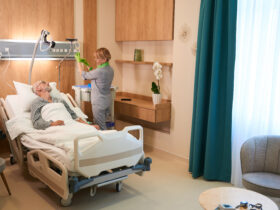As home health care becomes increasingly popular, technology is playing an ever bigger role in helping to provide the best possible care. From a specialized vagus nerve stimulation device designed to improve overall health and wellness to home monitoring systems that alert medical staff of changes in a patient’s condition, there are now more options than ever for home healthcare providers.
During this article, we’ll take a look at some of the most innovative home health technologies available today and how they can help patients receive the best possible care from their own homes.
Vagus Nerve Stimulation as a Home Remedy
One of the most popular home health technologies is vagus nerve stimulation. This technology uses electrodes placed around a patient’s neck to stimulate the vagus nerve, which can potentially help reduce pain, anxiety, and depression.
VNS devices, for short, are often used in conjunction with home monitoring systems that track patients’ vital signs and alert medical professionals when something is amiss.
This is another tool that the medical professional can use that is guided by the patient in their own homes and so less intrusive a way of delivering a medical solution. It is for users to decide how much benefit can be obtained from such a device. Many will consider it worth trying when they have not been successful with other medical approaches.
Health professionals should be able to advise you on the best device to go for and ones that have the features that may benefit your condition. You will want to know that it has the potential at least to treat what you are suffering from.
Home Medical Services
Some home healthcare providers also offer home-based physical therapy and occupational therapy, which can be useful for those who have difficulty getting out of their homes due to mobility issues. This type of technology helps home health professionals customize treatments based on the individual needs of each patient.
Many conditions are better controlled by home treatments. It encourages patients to want to go ahead with treatments they might otherwise put off because of “white coat syndrome” or fear of doctors and medical environments.
Smart Home Technology
This type of technology also makes it easier to monitor patients from a distance. Smart home technology, such as mobile apps or home monitoring systems, can be used to track vital signs and alert medical personnel if something changes in a patient’s condition.
Home monitoring systems can also be used to track things like temperature and oxygen levels, allowing home healthcare providers to quickly identify any potential issues with a patient’s health. These systems are especially helpful for people living in remote areas or those who aren’t able to easily get to their doctor’s office.
More can be achieved inside the home than ever before and there is no reason why this cannot extend to things that benefit health. For instance, an HVAC (Heating, Ventilation, and Air Conditioning) system can mean better air quality because it has removed the dust irritants likely to worsen breathing conditions such as asthma.
Telehealth Services
Other home health technologies include home-based telehealth services, which allow patients to receive medical advice remotely, and home-based medication delivery systems that help ensure that a patient is taking their medications correctly.
It is much more efficient for doctors to assess some of their patients remotely when questioning and distance observation is possible for a good diagnosis.
Conclusion
With so many potential home health technologies available, home health care providers need to understand the different options so they can choose the best technology for their patients. By understanding the benefits and limitations of home health technology, healthcare providers can ensure that their patients are receiving the best possible care from their own homes.













Leave a Reply